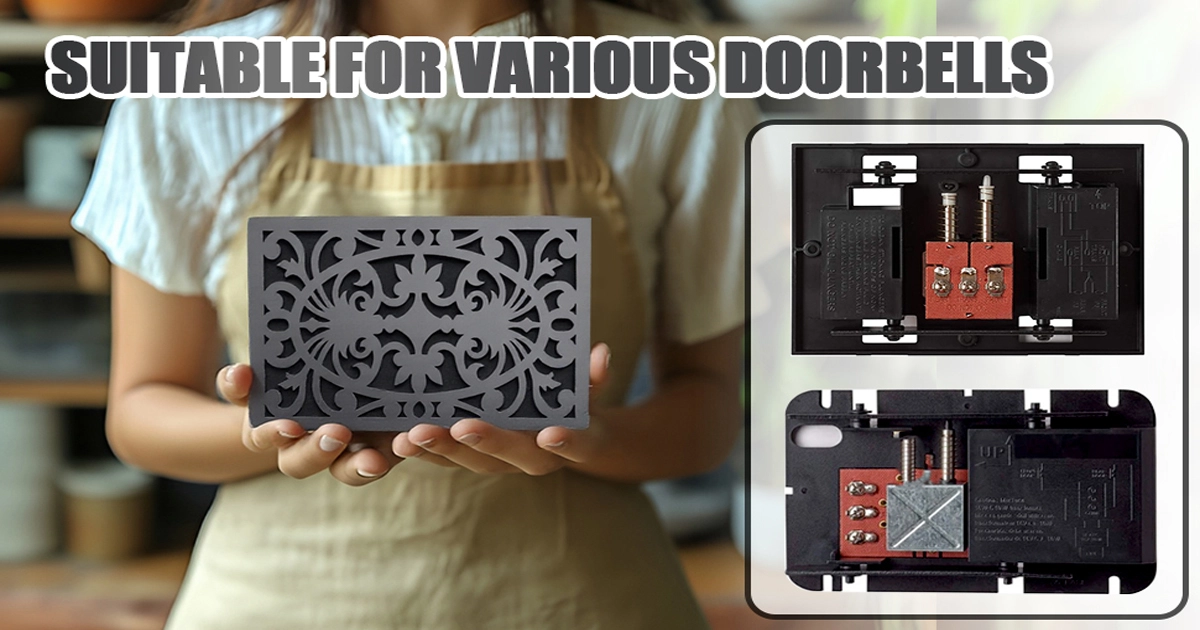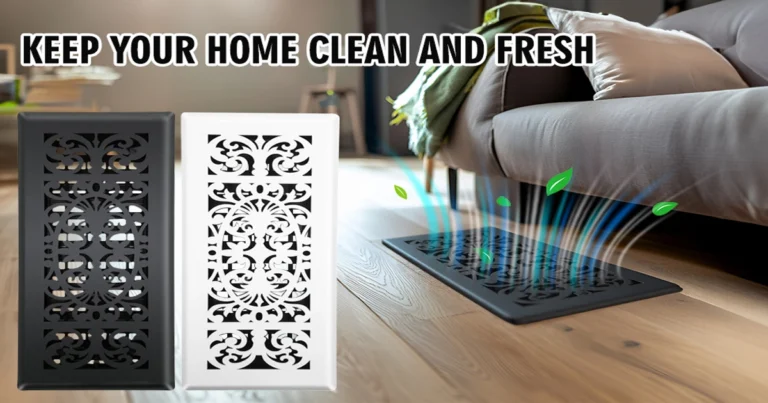How to Choose the Perfect Doorbell Chime Cover: A Homeowner’s Guide
Most of us know the feeling – that eyesore of a doorbell stuck in a time warp. Many homeowners keep their unattractive doorbells for over 18 years, calling them “ugly” or worse. The frustration hits hard when you look at an outdated doorbell chime cover or a modern smart doorbell that clashes with your home’s style.
The good news? You don’t need expensive replacements or a complete system overhaul to upgrade this overlooked home feature. New doorbell covers typically cost around $40, but we found many creative alternatives. You can craft custom doorbell chime box covers from scrap wood or design modern solutions that blend naturally with your interior. This piece will show you how to pick and customize the perfect doorbell cover that works great and boosts your home’s visual appeal.
Types of Doorbell Chime Covers
Doorbell chime covers come in all sizes and materials, and each type brings something special to different homes. The mechanical chimes make that classic “ding-dong” sound with their metal parts and spring-loaded levers . Electronic chimes create digital tunes through speakers and usually come with sleeker designs that let you adjust their settings .
Wooden covers are a great choice that adds warmth and character to any room, whatever the wall color might be. You’ll often see beautiful details like vertical slats in these covers that let the sound travel while showing off the natural wood grain patterns . These covers look amazing in everything from rich cherry to elegant mahogany finishes, and they last for years .
Stainless steel covers are perfect if you want something more modern. These newer designs usually give you multiple sound notes so you can tell the difference between front and side door rings . Their shiny surfaces and curved shapes naturally fit into modern and eclectic homes, matching well with other brushed nickel fixtures.
Some of the newer covers now come with LED lights, so they work as both doorbells and subtle light sources . These lights can be dimmed, which works great in darker areas like near staircases. On top of that, wireless digital receivers give you over fifty chimes to choose from – perfect if you’re renting or want something easy to install .
The sort of thing I love is the custom-made covers that let homeowners match exact sizes and design priorities. You can get these covers in single or two-color designs, up to 10 inches in size . Traditional-style covers often have gold or brass details with beveled edges, giving them that antique charm that makes them look more like wall art than just doorbells .
Clean-lined covers in neutral colors offer a refined look that doesn’t overwhelm the space – perfect for anyone who loves minimalist design. These subtle options work great in urban, modern, or farmhouse homes, fitting in with all kinds of design styles . Some models even include mission-style elements or window-pane shapes with LED lights that look great and work well .

Matching Your Home’s Style
The right Doorbell Cover Box needs more than just an attractive design. Your home’s architectural style should guide your choice. A cover might look perfect on its own but could clash with your overall décor.
Modern homes have many sleek options available. Brushed nickel finishes with thin metal bands create a sophisticated look that works well with contemporary esthetics. Glass doorbell covers will improve the chime’s sound quality while offering understated elegance, despite their delicate nature.
Rich wooden covers in cherry, oak, walnut, mahogany, or pine add warmth to traditional homes. These natural materials give you flexibility in mounting options. You can position the covers vertically or horizontally based on your space needs.
Artistic homeowners might prefer hand-carved covers with matte black scrolled finishes over tea-stained glass. These timeless pieces work well with both modern furnishings and traditional décor. Ornate scrolled resin designs featuring distressed crackle finishes create an antique look that becomes a natural conversation starter.
Industrial spaces look best with bold metallic finishes. White or black metal covers with sophisticated scrollwork mirror antique forced-air grates’ esthetic, adding understated elegance to commercial settings.
LED backlighting with adjustable brightness controls appears in some newer designs. These stylish yet practical options shine in dimly lit areas or help create ambient lighting effects.
Craftsman-style homes benefit from covers inspired by Shaker and Mission architecture that offer timeless charm. These pieces often include decorative patterns that turn a simple doorbell cover into an architectural feature enhancing your home’s character.
Proper sizing plays a vital role regardless of style choice. Take your existing unit’s height, width, and depth measurements and add half an inch to each dimension to ensure proper clearance. This attention to detail helps your chosen cover look beautiful and work perfectly.
Installation and Maintenance
Your doorbell chime cover will work perfectly when you install and maintain it properly. Switch off the power at your circuit breaker before you start any work to stay safe . Take off the old cover by lifting it up gently – you might need to loosen some screws first .
Clean the plunger mechanism really well to get the best performance from your new cover. Don’t use WD-40, oil, or silicon spray as lubricants because they attract dust and create problems later . A better option is electrical contact cleaner to get rid of dirt and debris .
The installation process needs careful attention to detail. Thread the wires through the back of your new chime unit. Connect the “Front” wires to their terminal, then attach the “Trans” and “Back” wires to their matching screws . Make the connections tight but don’t overdo it – you could damage the wires.
Your doorbell will work better when you:
- Keep the doorbell button clean and free of dirt
- Put weather-resistant sealant on outdoor parts
- Look at wire connections once a year and tighten them
- Put in new batteries before the old ones die in wireless systems
Custom fabric-covered chimes need Mod Podge to keep the material tight across the surface. Start with a coat on the frame’s front and smooth the fabric down carefully. Then coat the top edge and sides, and fold the corners like you’re wrapping a present .
Bad weather can be tough on doorbells, so check your system often if you live in a harsh climate . Pay attention to any weird sounds from the chime unit that might mean it needs fixing . The voltage rating of your chime (usually 12 to 24 volts) should match your transformer’s output .
Wireless doorbell cover work best when you check their maximum distance range before installing them . Your system might have multiple receivers, so place them strategically around your house for the best sound coverage .
Conclusion
Doorbell chime covers can enhance your home’s look without sacrificing function. My hands-on experience shows that three elements determine the best cover choice: your home’s architecture, installation methods, and upkeep routines.
The perfect cover might be a detailed wooden design or a modern LED-equipped model. The right measurements and careful setup will make a huge difference. Standard options work well for most homes, but custom designs give you complete creative freedom to match unique spaces.
A few simple maintenance steps will keep your new doorbell cover working smoothly. Clean it regularly, check the wires yearly, and fix any strange sounds right away.
Your doorbell cover does double duty as a practical item and design piece – definitely worth the effort to pick the right one. These tips will help you turn that old chime into an attractive feature that matches your home’s style.
FAQs
Q1. What are the different types of doorbell chime covers available? Doorbell chime covers come in various styles, including traditional wooden covers, modern minimalist designs, and smart doorbell compatible options. You can find covers made from materials like wood, stainless steel, and even decorative resin, each offering unique esthetic and functional benefits.
Q2. How do I choose a doorbell chime cover that matches my home’s style? Consider your home’s architectural style and existing decor. For contemporary homes, sleek metal or glass covers work well. Traditional homes benefit from wooden covers in rich finishes. Measure your existing doorbell box and add half an inch to each dimension to ensure a proper fit.
Q3. Can I install a new doorbell chime cover myself? Yes, you can install a new doorbell chime cover yourself. Start by turning off the power at the circuit breaker. Remove the old cover, clean the mechanism, and carefully connect the wires to the new unit. Avoid using lubricants, as they can attract dust and cause issues.
Q4. Where is the best place to mount a doorbell chime? The best location for a doorbell chime is typically at eye level where it can be both seen and heard easily. Common placements include near staircases or openings to common living areas. For multi-floor residences, consider installing it in the stairwell for optimal sound distribution throughout the house.
Q5. How do I maintain my doorbell chime cover? Regular maintenance includes cleaning the doorbell button, checking and tightening wire connections annually, and inspecting for weather-related damage in outdoor units. For wireless systems, replace batteries proactively. Listen for unusual sounds that might indicate wear or needed maintenance.


